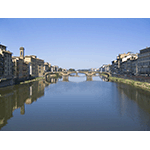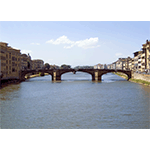Ponte Santa Trinita [Santa Trinita Bridge]
Since the very origins of Florence, the Arno represented a formidable infrastructure within the city, becoming increasingly important especially for exploitation of the hydraulic power needed to drive the numerous manufactories built along its banks: mills, kilns and "tiratoi" (buildings with terraces covered by roofing used for processing wool, the city's most important manufacturing activity). The Arno was also an important thoroughfare of communication, along which goods of every kind were transported on boats or the barges known as guatte. Timber was transported in a special way, according to the system known as floatation, in which the logs were bound together in foderi, then left to float downstream on the current. Along the section of the Arno passing through the city were river ports: the Porticciolo, upstream of Ponte Vecchio, and the ones near Ognissanti and Porta San Frediano, downstream. The Porticciolo lost its importance with the construction of the weirs of Santa Rosa and San Niccolò. The two parts of the city, on either side of the Arno, originally connected only by Ponte Vecchio, the marketplace over the river, were subsequently linked by Ponte Nuovo (1218-20), later called Ponte alla Carraia, destined to commercial traffic, by Ponte Rubaconte, now known as Ponte alle Grazie (1237), which soon took on a religious character, and lastly by Ponte a Santa Trinita (1252), which served the function of representation.
Florence has been struck by floods various times over the course of the centuries, causing destruction of the bridges, which were then always rebuilt. After the flood of 1557, Ponte Santa Trinita was rebuilt to the project of Bartolomeo Ammannati, who put to good use the advice given him by Michelangelo. It is a structure with three arches on pylons shaped like a ship's bow, a shape that lessens the impact of tree trunks swept along by floods. The arches present a distinctive curvature, called a catenary arch, that is, a curve designed by a chain suspended by the ends at two conveniently positioned points. This curvature was identified during the rebuilding of the bridge destroyed by German bombs, during World War I.
In crossing Ponte a Santa Trinita looking toward Ponte Vecchio, a fixed hydrometer, consisting of a rigid graduated rod serving to measure the level of the Arno, can be observed.
****************************
Texts by Graziano Magrini
English translation by Catherine Frost
Last update 01/feb/2008





